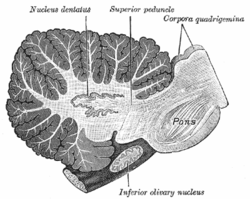This article needs more reliable medical references for verification or relies too heavily on primary sources .(June 2015) |
| Cerebellum | |
|---|---|
 A human brain, with the cerebellum colored in purple | |
 Drawing of the human brain, showing cerebellum and pons | |
| Details | |
| Part of | Metencephalon |
| Artery | SCA, AICA, PICA |
| Vein | superior, inferior |
| Identifiers | |
| NeuroLex ID | birnlex_1489 |
| Anatomical terms of neuroanatomy | |
Dyschronometria, also called dyschronia, is a condition of cerebellar dysfunction in which an individual cannot accurately estimate the amount of time that has passed (i.e., distorted time perception). It is associated with cerebellar ataxia, [1] [2] when the cerebellum has been damaged and does not function to its fullest ability. Lesions to the cerebellum can cause dyssynergia, dysmetria, dysdiadochokinesia, dysarthria, and ataxia of stance and gait. [3] Dyschronometria can result from autosomal dominant cerebellar ataxia (ADCA). [4]
Contents
- Signs and symptoms
- Dyschronia in children
- Causes
- Dyslexia
- Dementia
- Errors and inaccuracies
- Diagnosing
- Clinical testing
- Treatments
- Neuroplastic rehabilitation
- References
- External links


